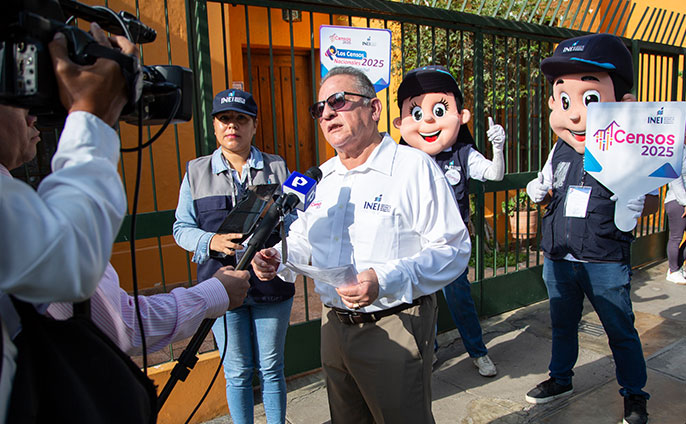INEI will prove procedures and methodology to ensure the success of the next 2025 National Censuses
Nota de prensa
26 de March de 2025 - 10:57 a. m.
From 26 March to 06 April of the current year, the National Institute of Statistics and Informatics (INEI) conducts the experimental census, preparatory activity for 2025 National Censuses: XIII of Población, VIII of Housing and IV of Indigenous Communities.
The experimental census aims to assess the procedures for each one of the census activities in order to make timely decisions that allows to perform the necessary adjustments and guarantee the success of the 2025 National Censuses.
In the city of Lima, the chief of the INEI, Dr. Gaspar Morán Flores, started the Experimental Census from the district of Barranco and he called the population to receive the INEI’s personnel and outstood the importance of this activity as part of the 2025 National Censuses that are in progress.
The experimental census is carried out in districts of the Coast, Highlands and Jungle of the country
In order to carry out the experimental census of population and housing there were selected six districts: Acomayo in Cusco, Palcamayo in Junín, Nueva Requena in Ucayali and the districts of Comas and Barranco in Lima. Meanwhile, the experimental census of indigenous communities will be carried out in Huaraz, Acomayo and Coronel Portillo.
The target population are the usual residents of housings, native and peasant communities of the selected areas for this important statistical activity.
Development of the experimental census
The census will be face-to-face, it means, that the census officials will visit the households of the selected districts and will interview a qualified informant of the household in order to complete the questions of the census form through an electronic device (Tablet).
In addition, it will be applied the Online Census (e-Census) by Internet in case the qualified informer is not at home or cannot attend the census official at the moment that he/she knocks the door and in that case the informer will complete the questionnaire accessing to the INEI’s website, using a housing code that will be left in a visit note.
For the census of indigenous communities, the census officials will visit the native and peasant communities of the selected departments and it will be used a digital census form, that includes questions adapted to cultural, sociologic and linguistic characteristics of the mentioned population groups.
INEI’s personnel will not enter the households
INEI’s personnel will not enter the households
For the experimental census will participate 160 census officers, from which, 144 will attend the population and housing census and 16 will attend the indigenous communities, whom have already been trained and will visit the households properly uniformed and identified.
It is important to outstood that for security measures, the INEI’s personnel should not enter the households in the course of performing the experimental census.
Subjects that will include the census form
The census form for the experimental census has questions referred to the characteristics of the housing (location, occupancy condition, type and number of homes, construction materials and basic services) characteristics of the household (fuel used for cooking, disposal of solid wastes and migration), access to health services, economic characteristics of the population, migration in households (members that had emigrated and causes of migration) and general information of the household members.